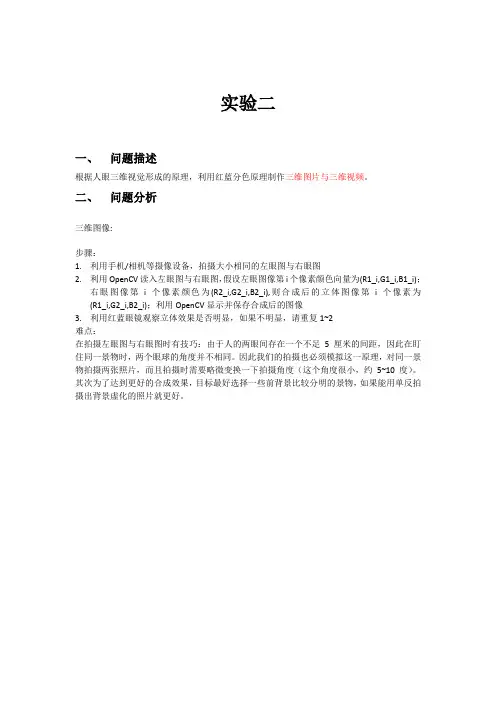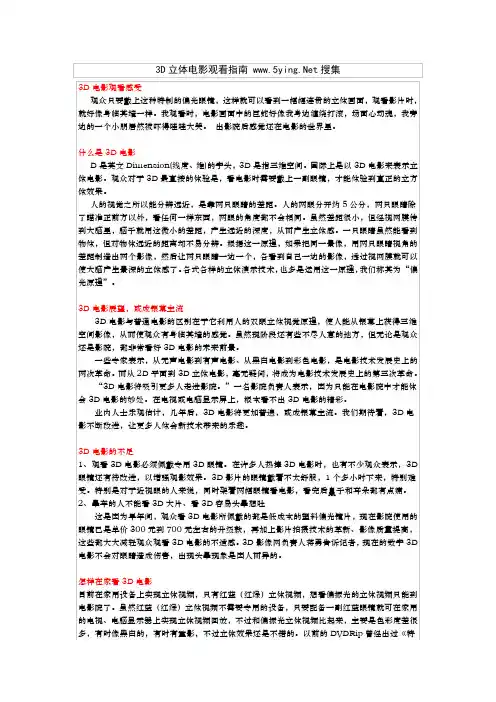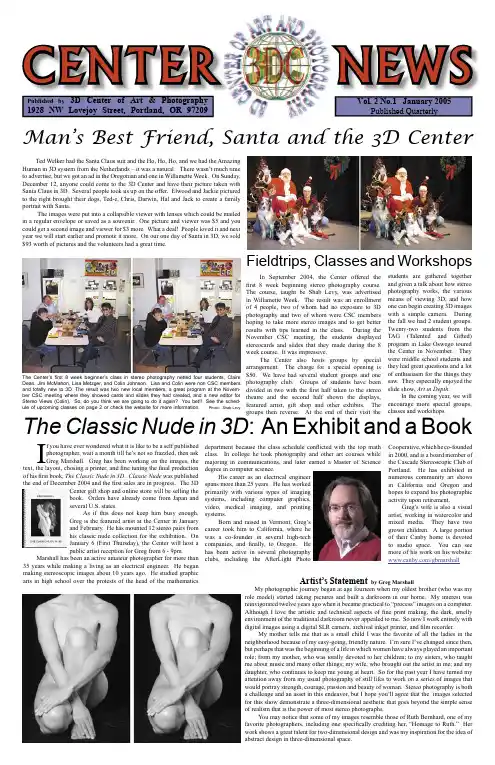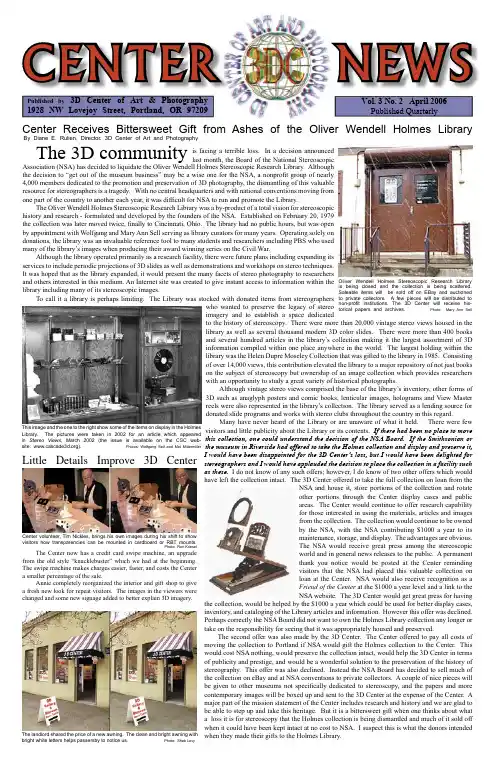3D红蓝图片
- 格式:ppt
- 大小:2.78 MB
- 文档页数:9



3D立体电影观看指南 搜集3D电影观看感受观众只要戴上这种特制的偏光眼镜,这样就可以看到一幅幅连贯的立体画面,观看影片时,就好像身临其境一样。
我观看时,电影画面中的巨蛇好像我身边缠绕打滚,场面心动魂,我旁边的一个小朋居然被吓得哇哇大哭。
出影院后感觉还在电影的世界里。
什么是3D电影D是英文Dimension(线度、维)的字头,3D是指三维空间。
国际上是以3D电影来表示立体电影。
观众对于3D最直接的体验是,看电影时需要戴上一副眼镜,才能体验到真正的立方体效果。
人的视觉之所以能分辨远近,是靠两只眼睛的差距。
人的两眼分开约5公分,两只眼睛除了瞄准正前方以外,看任何一样东西,两眼的角度都不会相同。
虽然差距很小,但经视网膜传到大脑里,脑子就用这微小的差距,产生远近的深度,从而产生立体感。
一只眼睛虽然能看到物体,但对物体远近的距离却不易分辨。
根据这一原理,如果把同一景像,用两只眼睛视角的差距制造出两个影像,然后让两只眼睛一边一个,各看到自己一边的影像,透过视网膜就可以使大脑产生景深的立体感了。
各式各样的立体演示技术,也多是运用这一原理,我们称其为“偏光原理”。
3D电影展望,或成银幕主流3D电影与普通电影的区别在于它利用人的双眼立体视觉原理,使人能从银幕上获得三维空间影像,从而使观众有身临其境的感觉。
虽然现阶段还有些不尽人意的地方,但无论是观众还是影院,都非常看好3D电影的未来前景。
一些专家表示,从无声电影到有声电影、从黑白电影到彩色电影,是电影技术发展史上的两次革命。
而从2D平面到3D立体电影,毫无疑问,将成为电影技术发展史上的第三次革命。
“3D电影将吸引更多人走进影院。
”一名影院负责人表示,因为只能在电影院中才能体会3D电影的妙处。
在电视或电脑显示屏上,根本看不出3D电影的精彩。
业内人士乐观估计,几年后,3D电影将更加普遍,或成银幕主流。
我们期待着,3D电影不断改进,让更多人体会新技术带来的乐趣。
3D电影的不足1、观看3D电影必须佩戴专用3D眼镜。

3D电视原理介绍和各种3D技术3D电视原理介绍自阿凡达引发3D体验狂潮之后,作为上市不到1年的电视品类,3D可谓创下了有史以来普及最快、接受度最高的消费奇观,将年初人们对3D“叫好不叫座”的担忧彻底瓦解。
针对这一现象,记者陆续走访了中国电子商会副秘书长陆刃波、奥维咨询高级分析师等多名资深行业专家。
专家谈到:今年国庆之所以会有如此强悍的市场表现,从平板电视市场消费需求和技术发展趋势看,虽是意料之外,也是情理之中。
超高性价比、超强观看体验、并辅之以技术领跑,3D电视未来形势值得看好。
一、什么是3D电视?3D是three-dimensional的缩写,就是三维立体图形。
由于人的双眼观察物体的角度略有差异,因此能够辨别物体远近,产生立体的视觉。
三维立体影像电视正是利用这个原理,把左右眼所看到的影像分离。
时分3D液晶电视的立体显示效果,是通过在液晶面板上轮流播放左右眼的信号,用户借助同步开关的立体眼镜,将经过编码处理的3D视频影像独立送入人的左右眼,即能体验触手可及的立体影响。
总的来说,3D一般意义上指的就是三维空间,也就是我们生活的这个空间。
三维空间与二维、一维空间的最大区别就是“立体”。
因为这个特性,一些立体声音响会在宣传中加入“3D”字样,这里仅仅代表的是“立体”声,所以应该区别。
3D引擎是一些电脑中的3D图像绘制所要用到的核心软件,不同的图形引擎往往代表了不同的画面效果,如著名的“虚幻”引擎。
这里的3D绘图也就是我们现在在电脑上接触的最多的3D图形,和立体3D有本质上的区别,一个是画面生成形式,一个是画面的显示形式,两者及容易混淆。
谈到立体,这里就不得不说一下一维、二维空间的特征。
其实很简单,一维可以被理解为一根线,这根线只能两边无限延伸。
二维高于一维,拥有一个面上任意延伸的坐标属性,也就是我们通常所说的平面。
三维高于二维的特征就是在这个平面上多出了“上下”两个坐标,使物体突出于平面的面,形成我们所谓的“立体”。
![[红蓝格式][3D电影下载]3D《环太平洋》左右上下蓝光原盘12.8GBT下载1080P](https://uimg.taocdn.com/c176a978571252d380eb6294dd88d0d233d43ce0.webp)
[红蓝格式][3D电影下载]3D《环太平洋》左右上下蓝光原盘12.8GBT下载1080P◎译 名 环太平洋/悍战太平洋(港)◎⽚ 名 Pacific Rim◎年 代 2013◎国 家 美国◎类 别 动作/冒险/奇幻/科幻◎语 ⾔ 英语◎上映⽇期 2013-07-31(中国⼤陆)/2013-07-12(美国)◎IMDB评分 7.5/10 from 113,371 users◎⽂件信息 DTS x264 需⽀持DTS解码◎⽚ 长 131 min◎导 演 吉尔莫·德尔·托罗 Guillermo del Toro◎主 演 查理·汉纳姆 Charlie Hunnam ....罗利 Raleigh Becket 伊德瑞斯·艾尔巴 Idris Elba ....潘特科斯特 Stacker Pentecost 菊地凛⼦ Rinko Kikuchi ....⿇⼦ Mako Mori 朗·普尔曼 Ron Perlman ....汉尼拔·周 Hannibal Chau 查理·戴 Charlie Day ....纽顿博⼠ Dr. Newton Geiszler 伯恩·⼽曼 Burn Gorman ....赫尔曼博⼠ Dr. Hermann Gottlieb 麦克斯·马蒂尼 Max Martini ....赫克·汉森 Herc Hansen 罗伯特·卡⾟斯基 Robert Kazinsky ....查克·汉森 Chuck Hansen 芦⽥爱菜 Mana Ashida ....幼年⿇⼦ Young Mako ⼩克利夫顿·克林斯 Clifton Collins Jr. ....天童 Tendo Choi 迭⼽·克莱特霍夫 Diego Klattenhoff ....扬希 Yancy Becket 罗伯特·梅耶 Robert Maillet ....艾⼒克西斯·凯戴诺夫斯基 Aleksis Kai◎简 介 《环太平洋》是发⽣在两个世界(平⾏宇宙)中的故事:其中⼀个另类宇宙是近未来的地球,在这个世界⾥,2012年11⽉发⽣了⼀件重⼤事件——第⼀只 kaiju(⼀种类似与哥斯拉的巨型怪兽)由太平洋海底的⼀个洞⽳中出现,接着攻击了⼈类城市。

3D立体影片格局介绍1. 双色3D,包含红蓝、红绿等.之邯郸勺丸创作2. 偏振3D,包含左右格局影片,上下格局.3. 分时3D,也叫电子快门式3D.这三种要带不合的眼镜不雅看,后两种还需要播放设备的支持.3D立体影片格局主要分为两种,我们经常俗称为真3D和伪3D以下辨别解释一下,也是分为A、B两种,A为立体电影,B为互补色影片.大家可以套用上述俗称,不过不建议这样做.A:立体电影.不管是左右别离、左右合成、上下合成、交错格局,都可以用Stereoscopic Player等播放软件播放成双屏输出,跨屏,左右画面,上下画面,交错画面,及播放成红蓝,绿红,黄蓝等显示方法,可以说是涉及到立体的全部显示计划,也就是俗称的真3D.那么这几种格局有什么优缺点呢?下面细细道来.1、左右别离:左右别离也叫两路视频,**两路视频,原则上效果跟左右合成,上下合成效果一样,其实未必,左右别离格局是目前公认的最好偏光立体电影,自然有它的原因,主要有以下优点:左右别离视频可以加入**的音轨文件AC3,想任意换国语,粤语,英语,只要有**音轨都可便利加入使用,而现在AC35.1声道的音轨到处都是,这样左右别离的立体电影轻松实践左右主响外,还实践了合音响,环绕声,低音炮,甚至7.1声道都不是梦想,成为真正4D级此外商业效果,左右格局的短片同时也支持连播,如果左右调错更便利更名,同时支持影讯设置,快捷便利,目前左右别离电影最好的可达1080高清,是目前最好,最受欢迎的商业立体影片格局,唯一的缺点高清的左右别离是对电脑主机和显卡要求较高,体积也较大.2、左右合成:左右合成把左右两路合成一个视频的偏振格局,同时也合成了音轨,左右合成的偏振电影一般较宽的非尺度格局(未必是非尺度压缩),因此很多商家以分辩率骗外行人(比方1280X480的分辩率,有的商家还号称720高清,720高清分辩率是1280X720,而1280X480的左右合成格局实际上的分辩率才640X480,比DVD的分辩率还低,达不克不及最少的商业要求),左右合成的分辩率的算法是宽度除2,而高度不变,左右格局的优点是:最便利看立体,就算用狂风影间播放也能用不雅屏镜或斗鸡眼**直接看高质量立体,左右格局短片也可以连播,缺点是无法加入**的5.1音轨AC3,视频格局并尺度,高清的左右格局对电脑主机和显卡要求较高.3、上下格局:上下格局和左右格局的基本一样,也是非尺度的长宽比的视频格局,上下格局是上下排放的,上下格局的产生最初是因当时辉煌一时的红网眼镜立体时代,因现在流行的宽屏的16:9立体电影做成上下格局,2D播放时拥有更大的可视面积,上下格局的真正分辩率算法是宽度不变,高度除以2,上下格局的主要优点是:上下格局也是**的偏振格局之一,可做成最高1080高清的上下格局,便利红网不雅看,短片能连播,也能支持影讯设置一劳永逸,缺点是无法加入**的5.1音轨AC3,高清上下格局对电脑和显卡要求较高.4、逐行扫描交错格局:这种是看上去两重影的交错格局,是一种比较科学,比较庞杂的偏振立体格局,这种扫描方法的交错格局运用上了反交错技术,交错格局也是市场上唯一长宽比尺度,视频长宽比也尺度的偏振格局,可以做成尺度的DVD,便利信号储存,于是交错格局的立体电影因些产生,想想左右格局要做成DVD也是不成能的,除非颜色很是差的红蓝电影,那是无法相提并论的;逐行扫描交错格局最致命的弱点是仍然沿用MPG的反交错技术,高清时代面临极大的挑战甚至淘汰,720以上的交错几乎不见了踪影,为什么呢,主机是现在的高清压缩技术和容积的原因,但目前而论逐行扫描交错格局比隔行分辩率来得好,逐行扫描交错格局是尺度化的标清格局,分辩率算法还是原来的分辩率不变,但转换成左右格局后发明原来的影像不如原来的左右格局好,主要是这种技术的反交错帧加场信息压缩的原因,交错格局对电脑要求不高,可以连播放.缺点是新手很难播放成双输出,主要是解码不支持或没设置好,还有就算是非编老手未必会懂如何把交错格局别离成左右两路,让人哭笑不得.5、隔行扫描交错格局:这种是垂直标的目的交错隔行扫描的条形交错格局,是以交错场直接显示一幅立体帧的这种电影看上去花,其实不然,这种电影也有做成尺度的DVD格局,用DVD播放机连接交错的三维显示器在一定的分辩率下也能不雅看,但由于隔行扫描的是较老技术,得不到高清时代很多设置的认可,这种交错模式的高清片其实很多见,但不克不及说没有,最新的阿凡达也出现过这种隔行交错扫描的720预告片,分辩率的算法是宽度不变,高度除以2,影像不变形,是比较科学的一种储存格局,或许也有可能成为下一代的电台立体频道信号尺度,隔行扫描的优点是对电脑要求不高,也较好播放成两路别离而不必去设解码,可实践连播,混播及影讯设置,缺点是分辩率较低下了,480P的效果好不上高清的红蓝,支持**音轨除了左右别离格局我自然不必多提了.想转换成左右格局,也不是一般的高手可言的,除非用专业的软件.B:互补色影片.红蓝、红绿,黄蓝,绿红等互补色影片不克不及播放成左右画面,上下画面及交错画面,只能用普通的播放软件2D播放或Stereoscopic Player播放成2D模式戴上相应的立体眼镜不雅看.1、绿红格局:(绿品红格局)绿红格局实际上应该叫绿品红格局,这种立体电影是近两年内比较流行,比较罕见的影片有地心游,我的血腥情人节,卡若琳(鬼妈妈)等到立体电影片,相信会成为互补色电影的新宠,主要是画面比较柔和比红蓝(红青)电影相比,红色显示更鲜艳,因为绿和品红原本就是互补色,这两互补色比较不暗,更能显示柔和的细节.2、红蓝格局(红青格局):红蓝格局实际上正式名称是红青格局,也是我们应用最广泛的互补色格局,也就是我们所说的红青格局,它主要是以红色储存左路信息,青色储存右路信息,当然右路信息包含绿色和蓝色信息,右路信息较为丰厚,由于大家都把它叫做红蓝格局了,不是说我不分青红皂白,当然我也是这方面的专家,我可没有责怪大家的意思,事实不知什么时候起,我们把红青电影叫做了红蓝电影,红蓝眼镜了,我只想在这里给大家纠正一下科学的叫法,红青电影并没有过人之处,比起红蓝,它滤色没这么暗,滤色可容度更大更强,缺点还是有的,红色是原色,是组成自然界的关分健色度之一,把左边影像当做原色色度储存当然看了很晕眼,归正互被色看了都晕眼,但红青互补色格局给脑的信息就是立体感强,这也是胜绿品红电影的过人之处.3、红绿格局:红绿格局就是红色通道和绿色通道做成左右的立体电影格局之一,红色通道储存左路信息,绿色通道储存右路信息,绿色包含**和蓝色的组合信息,右路相比左路信息较丰厚,两眼不雅看后反响到脑部,红和绿混合就是接近黑色,还原接近原来立体景象的意思,红蓝电影没有比红绿电影差多少,主要还是绿色的会比青色的暗一些,滤色兼容性没有青色大一些,于是远没有红青格局普及.您好,我是HTC大陆地区的初级技术工程师,关于你这个问题最近我正好为公司写了一篇关于EVO 3D裸眼3D方面的技术文档,里面包含了这款手机的使用和3D原理,包含你最想知道的关于裸眼3D 电影下载的内容,下面就是此技术文档内容:HTC EVO 3D(夺目)使用何种3D方法因为手机是移动手持设备,屏幕不成能做的很大,所以一般拥有裸眼3D功效的手机都是采取左右式或上下式3D视频,而HTC EVO 3D使用的就是其中的左右式3D视频播放方法,但是目前因为裸眼3D技术还处在成长阶段,不是很成熟,所以在手机上看裸眼3D视频还是会有感到很花,甚至看久了会有头晕的感到,并且3D效果的可视角度也很小,一旦看的时候偏一点就完全花了,视频效果的好坏和原视频文件也有直接的联系关系,最主要在两点:1:原视频文件的分辩率——如果原视频文件的分辩率比较低,那转换出来的视频将很难体现出3D效果(不雅看时感到3D效果很浅),有些转换软件是可以强制修改3D效果的深度,但是还是不怎么明显.2:转换后视频文件的播放帧数——如果转换后视频文件的播放帧数比较低,那如果视频里有快速物体移动的镜头的话(比方一辆车高速驶过),那看到的效果就会产生很明显的拖尾现象.不过转换后视频文件的播放帧数是可以通过转换软件直接设置的,一般最高可以设置到30帧/秒.所以主要的还是要看原视频文件的分辩率,还有就是在EVO 3D里播放3D视频的话一定要把视频转换成MP4格局才可以.不然的话那播放出来的就是两段同样的视频同时播放,而进不了3D效果.团体推荐软件和下载网站:1:ArcSoft MediaConverter 7——款很是不错的2D,3D视频转换软件,除了视频外还可以转换图片等,还可以自定义设置3D效果和分辩率,但是缺点是转换后的视频容量会比较大.2:格局工场——很知名的格局转换软件,可以把视频文件转换成几乎所需要的所有格局,并且支持分辩率,屏幕大小比,视频帧数的自由设置.优点是转换自由度很高,缺点是转换视频需要的时间比较长.3:立体中国——国内最大的3D视频下载网站,里面包含了左右式、上下式、红蓝式等等片源,甚至连专业3D影院用的片源也找的到,最近还推出了手机版,实现了可以用裸眼3D手机在线不雅看裸眼3D电影的功效.转换方法:一般先使用ArcSoft MediaConverter 7来把原视频转换成左右格局的3D视频,然后通过格局工场来转换成合适大小,分辩率和视频帧数的修改.(推荐设置分辩率为1280×720,视频帧数设置为30帧,因为这款手机的视频播放分辩率的最大值就是720P,所以不克不及选择超出720的分辩率,不然会出现视频无法播放或者只有声音没有画面的情况).手机播放方法:把转换好的左右格局的3D视频放到手机SD卡中后,点击打开,然后点击菜单键,选择以3D模式播放就可以了!备注:鉴于曾遇到过通过格局工场转换后的视频在手机里播放时无法显示全屏效果的问题可以通过格局工场在转换前的设置来解决,那为什么会在转换后无法显示全屏呢?主要的方面只有一点,就是转换的视频在2D播放的时候是有黑边的,不是全屏播放的视频,那这种视频进行转换后会强制压缩宽高比,导致放到手机里后无法显示全屏,那么解决方法也比较简单,在格局工场的设置里把屏幕宽高比选择成4:3或者5:4后就可以了!赞同1|评论。


If you have ever wondered what it is like to be a self published photographer, wait a month till he’s not so frazzled, then ask Greg Marshall. Greg has been working on the images, thetext, the layout, chosing a printer, and fi ne tuning the fi nal production of his fi rst book, The Classic Nude in 3D . Classic Nude was published the end of December 2004 and the fi rst sales are in progress. The 3DCenter gift shop and online store will be selling the book. Orders have already come from Japan and several U.S. states.As if this does not keep him busy enough, Greg is the featured artist at the Center in January and February. He has mounted 12 stereo pairs from his classic nude collection for the exhibition. On January 6 (First Thursday), the Center will host a public artist reception for Greg from 6 - 9pm.Marshall has been an active amateur photographer for more than 35 years while making a living as an electrical engineer. He began making stereoscopic images about 10 years ago. He studied graphic arts in high school over the protests of the head of the mathematicsCooperative, which he co-founded in 2000, and is a board member of the Cascade Stereoscopic Club of Portland. He has exhibited in numerous community art shows in California and Oregon and hopes to expand his photographic activity upon retirement.Greg’s wife is also a visual artist, working in watercolor and mixed media. They have two grown children. A large portion of their Canby home is devoted to studio space. You can see more of his work on his website: /gbmarshallCENTERNEWSPublished by 1928 NW Lovejoy Street, Portland, OR 97209Man’s Best Friend, Santa and the 3D CenterThe Classic Nude in 3D :An Exhibit and a BookArtist’s Statement by Greg MarshallMy photographic journey began at age fourteen when my oldest brother (who was my role model) started taking pictures and built a darkroom in our home. My interest was reinvigorated twelve years ago when it became practical to “process” images on a computer. Although I love the artistic and technical aspects of fi ne print making, the dark, smelly environment of the traditional darkroom never appealed to me. So now I work entirely with digital images using a digital SLR camera, archival inkjet printer, and fi lm recorder.My mother tells me that as a small child I was the favorite of all the ladies in the neighborhood because of my easy-going, friendly nature. I’m sure I’ve changed since then, but perhaps that was the beginning of a life in which women have always played an important role; from my mother, who was totally devoted to her children; to my sisters, who taught me about music and many other things; my wife, who brought out the artist in me; and my daughter, who continues to keep me young at heart. So for the past year I have turned my attention away from my usual photography of still lifes to work on a series of images that would portray strength, courage, passion and beauty of woman. Stereo photography is both a challenge and an asset in this endeavor, but I hope you’ll agree that the images selected for this show demonstrate a three-dimensional aesthetic that goes beyond the simple sense of realism that is the power of most stereo photographs.You may notice that some of my images resemble those of Ruth Bernhard, one of my favorite photographers, including one specifi cally crediting her, “Homage to Ruth.” Her work shows a great talent for two-dimensional design and was my inspiration for the idea of abstract design in three-dimensional space.department because the class schedule confl icted with the top math class. In college he took photography and other art courses while majoring in communications, and later earned a Master of Science degree in computer science.His career as an electrical engineer spans more than 25 years. He has worked primarily with various types of imaging systems, including computer graphics, video, medical imaging, and printing systems.Born and raised in Vermont, Greg’s career took him to California, where he was a co-founder in several high-tech companies, and fi nally, to Oregon. He has been active in several photography clubs, including the AfterLight Photo The Center’s fi rst 8 week beginner’s class in stereo photography netted four students, Claire Dean, Jim McMahon, Lisa Metzger, and Colin Johnson. Lisa and Colin were non CSC members and totally new to 3D. The result was two new local members, a great program at the Novem-ber CSC meeting where they showed cards and slides they had created, and a new editor for Stereo Views (Colin). So, do you think we are going to do it again? You bet!! See the sched-ule of upcoming classes on page 2 or check the website for more information. Photo: Shab LevyTed Welker had the Santa Claus suit and the Ho, Ho, Ho, and we had the Amazing Human in 3D system from the Netherlands – it was a natural. There wasn’t much time to advertise, but we got an ad in the Oregonian and one in Willamette Week. On Sunday, December 12, anyone could come to the 3D Center and have their picture taken with Santa Claus in 3D. Several people took us up on the offer. Elwood and Jackie pictured to the right brought their dogs, Ted-e, Chris, Darwin, Hal and Jack to create a family portrait with Santa.The images were put into a collapsible viewer with lenses which could be mailed in a regular envelope or saved as a souvenir. One picture and viewer was $5 and you could get a second image and viewer for $3 more. What a deal! People loved it and next year we will start earlier and promote it more. On our one day of Santa in 3D, we sold $93 worth of pictures and the volunteers had a great time.Fieldtrips, Classes and WorkshopsIn September 2004, the Center offered the fi rst 8 week beginning stereo photography course. The course, taught be Shab Levy, was advertised in Willamette Week. The result was an enrollment of 4 people, two of whom had no exposure to 3D photography and two of whom were CSC members hoping to take more stereo images and to get better results with tips learned in the class. During the November CSC meeting, the students displayed stereocards and slides that they made during the 8 week course. It was impressive.The Center also hosts groups by special arrangement. The charge for a special opening is $50. We have had several student groups and one photography club. Groups of students have been divided in two with the fi rst half taken to the stereo theatre and the second half shown the displays, featured artist, gift shop and other exhibits. The groups then reverse. At the end of their visit thestudents are gathered together and given a talk about how stereo photography works, the various means of viewing 3D, and how one can begin creating 3D images with a simple camera. During the fall we had 2 student groups. Twenty-two students from the TAG (Talented and Gifted) program in Lake Oswego toured the Center in November. They were middle school students and they had great questions and a lot of enthusiasm for the things they saw. They especially enjoyed the slide show, Art in Depth .In the coming year, we will encourage more special groups, classes and workshops.Second year goals for the Center will be largely dictated by what slipped through the cracks the fi rst year. With noidea how challenging it would be to start a business from scratch, we embarked on this project last year with a great deal of enthusiasm, some skills that each of us brought to the venture, lots of ideas, andonly a dim grasp of the details. My grandmother used to say, “The Devil is in the details.” One example is the gift shop. In order to get items wholesale we needed to buy them in some quantity, then break them down into smaller units so we could mark them up to retail price and make some money on them. Because we wanted to encourage beginners, I took boxes of RBT mounts (50 in a box) and broke them into units of 18 mounts (enough for one roll of fi lm). This meant counting, packing in baggies, designing a label to staple on the top, pricing, etc. So it was with QVu mounts, and other small items. Designing and printing signage and labels became a major time drain. Of course we also had to fi nd the items we wanted to sell and we needed to fi nd them from the wholesalers, not the people who were selling them for the same prices we wanted to sell them for. Unlike last year, this year we begin with a stocked gift store, a list of sources for products, some packaging and signage.Establishing systems was another drain on time. We developed protocol for volunteers, exhibiting artists, inventory, accounting for money coming inand going out, fundraisers, brochures (design and distribution), and dealing with advertising and promotion. While there is plenty of room for improvement, we have done a fairly good job setting up a structure.Remembering that we started from an ugly empty space, the accomplishments of the past year are remarkable. The support in the form of donations,exhibits and time have made this possible. Last month the new phone books came out and for the fi rst time the 3D Center of Art and Photography is listed under museums. The Portland Oregon Visitors Bureau’s book of things to do and see in Portland came out in October and for the fi rst time, we were listed. If you search the web for 3D Center of Art and Photography you will fi nd us listed in some interesting places. Despite the fact that we could never fi nd the time to promotespecial openings, we have had fi ve groups arrange fi eldtripsto the Center, four student events and one fl at camera club. Next year we need to develop a promo package for Portland/Vancouver area middle school and high school students and for retirement communities to encourage more group outings.Expanding the number of CSC-sponsored products offered in the gift store and online will increasethe revenue fl ow for the Center, will encourage ideas and experimentation among amateur stereo photographers andwill make the Center unique in its offerings. Of course some well established 3D products simply must be available, but the combination of the expected and unexpected can bevery compelling to both the new and veteran visitor. Greg Marshall’s new book is an example. I like to think that the availability of the 3D Center for marketing and promoting such a book was a factor in Greg’s decision to launch into creatinghis fi rst book. It will be fun to see who else might decide togive a new idea a try.Occasionally during the past year I mentioned variousplans for stabilizing staff. None of these have worked out and part of it has been lack of time to seriously pursue them. We were unable to get an intern from one of the local colleges and I had no time to write any grant proposalsthis year. We will need to devote some energy to resolving this issue for two reasons. First, we need some consistency in the staffi ng. We need someone who is there each day and can update the volunteers and keep track of day to day operations. I am working full time and cannot be that person. Secondly, we need to expand our public hours and can only do this with a staff person - probably paid. A staff person who would work 20hours a week would allow us to expand our hours and maintain the same number of volunteer hours we are currently staffi ng. Each shift would be one volunteer and the staff person. This will take serious consideration of budget, fundraising, and perhaps a grant. We have accomplished a great deal, but there is more to do and the fl ood of support indicates that many hopewe will succeed.Message from theDirector2nd Season’s Beginning LineupGoldDonated $500 to $1,999Dave Allen OR Anonymous CA Gordon Battaile ORRich & Susan Dubnow OR Clarence & Norma Eid ORRon & Pauline Frederickson CA Ron & Jeanne Kriesel OR Greg Marshall OR Martha A. McCann CARobert McMahon Fund of the Oregon Community Foundation J. Ward & Dodi O’Brien ORSusan Pinsky & David Starkman CA Paul Talbot TX Ted Welker ORPlatinumDonated $2,000 to 4,999Dwight Cummings WA Shab Levy OR John C. Little OR Dave Qualman WA Diane Rulien ORDiamondDonated $5,000 +Mark Gehlar ORJohn & Dace Roll ORCharter Pledges Donated $100 to $499American Paper Optics TN Hassan Atapour CA Bradley Belian MIBerezin Stereo Photography Products CA Bill & Janet Burkholder OH Randall K. Corey, O.D. ORDa Vinci Arts Middle School PTA OR Dr. & Mrs. Leo Dos Remedios CA Larry Ferguson NE Thomas E. Fiske OR Wm Fridrich NCMary Laura Gibbs TXJon Golden & Jan Burandt MA Gary Greenspoon Canada Loren Gunderson CO Michael Halle MA Norm Henkels CA Alan L. Huberty MISteve & Suzanne Hughes GA Dr. Stanley E. Jackson MD Adrienne Jaross CA Wm A. Jones WADonald M. Karp & Margery Lesnik Karp Foundation NJ Lawrence & Cassie Kaufman CA Steven Kiesling MILouis & Jeanette Knobbe CA Les & Jain Konrad OR Ron Labbe MAAriel & Debbie Levy CA Bruno A. Lizzi CABobbi & Ralph London OR Jeff & Roneete Lynas CA Alicia L. Lynch NV Michael McEachern AL Ken Miller ORSamuel W. Mitchell MO Marilyn F. Morton GA John T. Myers, M3 Inc. OR Mary Lou O’Brien WA Oregon 3D OR Donald J. Parks ID Alan W. Patterson ORPhilip & Keturah Pennington ORGreg Perez WADr. Jonathan D. Pfautz MA James & Deborah Purdon NJ Monte Ramstad MN Ray & Norma Rowe OR Russell Ruhlen CA Wojtek Rychlik CO Susie Rydquist ORBorje O. Saxberg WA Ed Shaw MA Albert L. Sieg NY Boris Starosta V A Glenn Stokes CA James G. Theivagt IL Jay E. Thomas CA John True WACharles C. VanPelt CA Donald E. Wallace OR Bill Walton GA John Yochem MNKaryn & Craig Zupke WAOne Unit = Five Hundred Dollars DonatedDonations Charter Goal 5,00015,00010,00020,00025,00030,00035,00040,00045,00050,000Dec 03Feb 04Jan 04Apr 04Mar 04May 04Jun 04Jul 04Aug 04Nov 03Sep/Oct/Nov Dec 04is the end of Charter Memberships. Ifyou would like to be included on the permanent plaques for Charter members or if you would like to move from your current placement to anoth-er plaque, mail your tax deductible donation to CSC, 1928 NW Lovejoy, Portland, OR 97209A word about the Charter goals and the budget:Like everything else this year, the budget was primarily a mystery to us. We did not know what sort of fi -nancial support we would receive from CSC members and the Stereo community at large. We tried to es-timate costs, but many things were only guesses. Having no track record we did not know if the gift store would be profi table, if people would donate at the door, if we could sustain our open hours with volunteers and how much advertising we might need. The goal chart to the left is correct in the amounts received, but the goal itself was pulled from thin air. Early this spring, the CSC Board will be taking a hard look at costs and income from our fi rst year of operation and will develop a budget based on some real experience.January 31, 2005By Diane RulienThe Classic Nude in 3D by Greg Marshall (see front page story)Unseen Ellis Island: Island of Hope, Island of Tears by Sheldon Aronow-itz and Gary Schacker will be showing every hour in the stereo theatre.World of Phantaglyphs by Owen Western is a wonderful collection of largeimages that pop up off the table to surprize and delight Center visi-tors. The image below should be viewed by laying this article fl at on the table and viewing at a 30 degree angle with anaglyph glasses.Combining contemporary images with historic images , Unseen El-lis Island is an award winning tour d’force . A nostalgic look at America’s portal is a masterful blending of old and new. The pro-duction won the Best of Theatre award at the 2004 NSA convention.December 31, 2004 - February 13, 2005Febuary 18 - March 27CSC’s Best, a juried selection of 3D art by CSC members, will include large side-by-side pairs and anaglyph prints. The Rose below by Paul Moeller will be among those being displayed.。

如有何形的蓝色的和绿红蓝本文件版权归有发生将追究形式的泄露、红蓝3D 电 红蓝3d 蓝色内容,只的眼镜过滤不图为影片《如何判断看电影的时绿色的综合色蓝3D 影归摩丁创想公究法律责任。
如使用和损害电影d 电影是指一只看到红色部不同的颜色而《阿凡达》红断是红蓝电时候,有模糊色。
但还应该影片技术公司所有。
除如贵公司决定害。
一般左眼红部分,右眼过而看到不同的红蓝3D 版,电影糊的边,一般该是蓝色深一术与红除贵公司外,任定不采用摩丁色镜片右眼过滤掉红色,的影像。
剧照-(需带般边是绿色的一些。
红蓝影片任何人或单位丁创想的顾问眼蓝色,画面左右眼看到带红蓝眼镜看的比较明显。
片会展广位未经许可不问和建议,亦面也是红蓝错到不同画面而看3D 效果)。
可以肯定就广告行不得复印、传亦应保证摩丁错位的,这样而产生立体感就是红绿。
红行业中的传递和使用本丁创想的知识样左眼的镜片感。
红蓝电影红蓝的不太清的应用本文件中的内识产权不会受片会过滤掉画影是通过不清楚,有点容,受到任画面同颜蓝色眼镜当它红蓝3D 电 关键是镜看红蓝3d红蓝3D 电● 优点:● 缺点:关键是和蓝色感觉挺很难有 所以观看设备互补式,又红蓝眼镜 左放映它通过蓝色镜电影的效果是你要选一副电影。
电影优缺点成本低,周图片颜色会是这个“红蓝色,常见的还挺好,自己买有完美的效果以,最好选用备-红蓝眼镜又称色差式的镜原理映机的画面通镜片(右眼)时果副滤色比较干点周期短---制作会有部分丢失”的颜色没有还有黄色、绿的时候就没果 用专门为影片镜简介的3D 眼镜。
通过红色镜片时大部分被过干净的红蓝眼作周期跟成本失。
从原理上有标准,不同绿色、青色、没法完全匹配片匹配色准的 红蓝眼镜片(左眼),拍过滤掉,只留眼镜。
只要有本以及实现技上说挺简单,同电影采用的洋红色等,配了,颜色差的红蓝镜。
是一种新型拍摄时剔除掉留下非常昏暗有一副不错技术相对其他但自己买眼的红蓝颜色实在电影院时一点红色过型的影视产品掉的红色像素暗的画面,这的眼镜,效果他3D 技术较眼镜看的时候实际是有区别时候眼镜是根过滤不完或者品,用于辅助素自动还原,这就很容易果相当震撼较快。

I would have been disappointed for the 3D Center’s loss, but I would have been delighted for stereographers and I would have applauded the decision to place the collection in a facility such as these. I do not know of any such offers; however, I do know of two other offers which would have left the collection intact. The 3D Center offered to take the full collection on loan from theNSA and house it, store portions of the collection and rotate other portions through the Center display cases and public areas. The Center would continue to offer research capability for those interested in using the materials, articles and images from the collection. The collection would continue to be owned by the NSA, with the NSA contributing $1000 a year to itsmaintenance, storage, and display. The advantages are obvious. The NSA would receive great press among the stereoscopicworld and in general news releases to the public. A permanent thank you notice would be posted at the Center reminding visitors that the NSA had placed this valuable collection on loan at the Center. NSA would also receive recognition as aFriend of the Center at the $1000 a year level and a link to theNSA website. The 3D Center would get great press for having the collection, would be helped by the $1000 a year which could be used for better display cases, inventory, and cataloging of the Library articles and information. However this offer was declined. Perhaps correctly the NSA Board did not want to own the Holmes Library collection any longer or take on the responsibility for seeing that it was appropriately housed and preserved.The second offer was also made by the 3D Center. The Center offered to pay all costs of moving the collection to Portland if NSA would gift the Holmes collection to the Center. This would cost NSA nothing, would preserve the collection intact, would help the 3D Center in terms of publicity and prestige, and would be a wonderful solution to the preservation of the history of stereography. This offer was also declined. Instead the NSA Board has decided to sell much of the collection on eBay and at NSA conventions to private collectors. A couple of nice pieces will be given to other museums not specifi cally dedicated to stereoscopy, and the papers and more contemporary images will be boxed up and sent to the 3D Center at the expense of the Center. A major part of the mission statement of the Center includes research and history and we are glad to be able to step up and take this heritage. But it is a bittersweet gift when one thinks about what a loss it is for stereoscopy that the Holmes collection is being dismantled and much of it sold off when it could have been kept intact at no cost to NSA. I suspect this is what the donors intendedwhen they made their gifts to the Holmes Library.The 3D communityis facing a terrible loss. In a decision announced last month, the Board of the National StereoscopicAssociation (NSA) has decided to liquidate the Oliver Wendell Holmes Stereoscopic Research Library. Although the decision to “get out of the museum business” may be a wise one for the NSA, a nonprofi t group of nearly 4,000 members dedicated to the promotion and preservation of 3D photography, the dismantling of this valuable resource for stereographers is a tragedy. With no central headquarters and with national conventions moving from one part of the country to another each year, it was diffi cult for NSA to run and promote the Library.The Oliver Wendell Holmes Stereoscopic Research Library was a by-product of a total vision for stereoscopic history and research - formulated and developed by the founders of the NSA. Established on February 20, 1979 the collection was later moved twice, fi nally to Cincinnati, Ohio. The library had no public hours, but was open by appointment with Wolfgang and Mary Ann Sell serving as library curators for many years. Operating solely on donations, the library was an invaluable reference tool to many students and researchers including PBS who used many of the library’s images when producing their award winning series on the Civil War.Although the library operated primarily as a research facility, there were future plans including expanding its services to include periodic projections of 3D slides as well as demonstrations and workshops on stereo techniques. It was hoped that as the library expanded, it would present the many facets of stereo photography to researchersand others interested in this medium. An Internet site was created to give instant access to information within the library including many of its stereoscopic images. To call it a library is perhaps limiting. The Library was stocked with donated items from stereographers who wanted to preserve the legacy of stereo imagery and to establish a space dedicatedto the history of stereoscopy. There were more than 20,000 vintage stereo views housed in the library as well as several thousand modern 3D color slides. There were more than 400 books and several hundred articles in the library’s collection making it the largest assortment of 3D information compiled within one place anywhere in the world. The largest holding within the library was the Helen Dupre Moseley Collection that was gifted to the library in 1985. Consisting of over 14,000 views, this contribution elevated the library to a major repository of not just books on the subject of stereoscopy but ownership of an image collection which provides researchers with an opportunity to study a great variety of historical photographs.Although vintage stereo views comprised the base of the library’s inventory, other forms of 3D such as anaglyph posters and comic books, lenticular images, holograms and View Master reels were also represented in the library’s collection. The library served as a lending source for donated slide programs and works with stereo clubs throughout the country in this regard.Many have never heard of the Library or are unaware of what it held. There were fewvisitors and little publicity about the Library or its contents. If there had been no place to move this collection, one could understand the decision of the NSA Board. If the Smithsonian or the museum in Riverside had offered to take the Holmes collection and display and preserve it,Vol. 3 No. 2 April 2006Published QuarterlyCENTERNEWSPublished by 1928 NW Lovejoy Street, Portland, OR 97209Center Receives Bittersweet Gift from Ashes of the Oliver Wendell Holmes LibraryThis image and the one to the right show some of the items on display in the HolmesLibrary. The pictures were taken in 2002 for an article which appearedin Stereo Views , March 2002 (the issue is available on the CSC web-site: ). Photos: Wolfgang Sell and MelMittermiller Oliver Wendell Holmes Stereoscopic Research Libraryis being closed and the collection is being scattered.Saleable items will be sold off on EBay and auctionedto private collectors. A few pieces will be distributed tonon-profi t institutions. The 3D Center will receive his-torical papers and archives. Photo: Mary AnnSellBy Diane E. Rulien, Director, 3D Center of Art and PhotographyLittle Details Improve 3DCenterCenter volunteer, Tim Nickles, brings his own images during his shift to show visitors how transparencies can be mounted in cardboard or RBT mounts.Photo: Ron Kriesel The Center now has a credit card swipe machine, an upgrade from the old style “knucklebuster” which we had at the beginning. The swipe machine makes charges easier, faster, and costs the Center a smaller percentage of the sale.Annie completely reorganized the interior and gift shop to givea fresh new look for repeat visitors. The images in the viewers werechanged and some new signage added to better explain 3D imagery.The landlord shared the price of a new awning. The clean and bright awning with bright white letters helps passersby to notice us. Photo: Shab LevyApril 6 through May 21May 25 through July 2The Strange Case of Dr. Addison and the Crosswell Twins Human Nature: Scenic Observations via StereographsStereo Theatre:Christopher Schneberger’sIn the Gallery: Ron Kriesel’s“In the spring of 1908, Dr. Charles Addison disappeared. The noted botanist, amateur zoologist, and photographer, had been making a series of images of a young girl named Regina Crosswell. Regina’s twin sister, Lydia, had died in the winter, though the circumstances were unclear. Dr. Addison, however, had become convinced that Lydia had not entirely departed from our earthly plane. Peruse the photographs Addison made and draw your own conclusions.”Combining a love of stereo photography with an appreciation for the beauty of a landscapes, Ron Kriesel has produced an impressive num-ber of breathtaking stereoscopic landscapes over more than 20 years as a stereographer. These large side by side stereo prints are a visual treat, especially when viewed with David Lee large format mirrored viewers.Stereo Theatre: Simon Bell’sLos Caros Viejos: Classic American Cars in CubaIn the Gallery: Amazing StereoJetsby Jim GaspariniSimon Bell’s passion for photography began when he was given a “box-brownie” camera at six years of age. That early interest developed into career inphotography, multimedia and 3D imagery that continues today.While in Cuba, Bell was fascinated by the vast numbers of classic American cars he saw on the streets. Locked in by the American embargo on trade with Cuba established in the 1960s after Fidel Castro took power, and the inability of Cuban citizens to replace older American cars with new ones, the American cars in Cuba were maintained and valued. With his ever present eye for beauty and the unusual, Bell started taking stereo images of the cars and the people. The result was a stereo slide show which won 3rd place at the NSA convention in 2004. The images of cars and people on the streets of Cuba are accompanied by native Cuban music. It is like being transported to another part of the world.First Thursday opens new exhibition with artist’s recep-tion for Jim Gasparini seen here greeting guests, answering questionsand enjoying a glass of wine. Gasparini, who lives in the Bay area, flew to Portland to help set up his show of 20 backlit stereojets, Amaz-ing StereoJets, the first such exhibition held at the Center. Gasparini’s stereojets in-cluded images from Burning Man (see When She Beckons shown as a stereo pair below), scenic lo-cations and a hippopotamus in a tank (a favorite amongvisitors). The images were a sensation for first time visitors as well as veteran stereographers. The experience was enhanced by Gasparini being available to answer questions about the locations and the process of making stereojets.Besides enjoying a glass of wine and light refreshments, visi-tors watched Simon Bell’s award winning slide show, Caros Viejos.Fundraising: the Never Ending Work of a Non-Profit MuseumDoes it seem like we are always fundraising? We are. The Portland Symphony, established more than 40 years ago, recently published that they receive less than 50% of their operating budget from ticket sales. This is not an uncommon statistic for non-profit symphonies, ballets, museums, art galleries, and theatres. The 3D Center is no exception. In 2004, our first year, 90% of our funding came from individual donations of 3D enthusiasts all over the U.S. The other 10 % came from admissions and gift shop sales. In 2005, we dramatically increased the number of visitors. Consequently, the amount of income from admissions and gift shop sales increased from 10% to 25% of our funding. Our costs also rose in 2005 as we hired a part-time employee.In an effort to expand our financial base, theCenter has submitted more than 37 grant proposals to foundations and businessessince December. The competition for this type of funding is fierce and weare just learning the ropes. Some have already sent usrejection letters; others are still considering our proposals. We received a $1000 grant from the Oregon Arts Commission last month and we got our first Corporate Friend membership from MacNaughton, Inc. Check our webpage under Friends for a link to their website. This month mailings for Friends renewals and solicitations for new Friends memberships will be mailed. Please support the Center with as generous a giftas you can. Each mailing you get is prepared, stuffed, addressed and mailed by volunteers because we need your support this year.D o l l a r s I n c o m e 2005D o l l a r sE x p e n d i t u r e s 2005New Acquisition Our thanks to John Little forhis donation of a dual stereo microscope, four eyepieces andRealist stereo camera. The dual stereo eyepieces allowone to observe and photo-graph in stereo at the sametime.Photo: Greg Marshall。

使用3D眼镜主要应用的光学原理1. 3D技术简介3D技术是一种用于增强立体感的视觉技术,通过模拟人眼的双眼视觉系统,使观看者能够感受到更加真实的场景。
3D眼镜是3D技术中的关键设备,并采用了特殊的光学原理来实现立体效果。
2. 3D眼镜的工作原理3D眼镜通过改变观看者的视觉输入,使一只眼睛看到一种图像,而另一只眼睛看到另一种图像。
这样,我们的大脑就会将这两个图像合成为一个立体的图像,从而产生立体效果。
3. 使用3D眼镜的主要原理使用3D眼镜的主要原理包括极化光原理和颜色滤镜原理。
3.1 极化光原理极化光原理是使用3D眼镜的一种常见方法。
这种方法使用了圆偏振镜和线偏振镜来实现立体效果。
- 圆偏振镜:圆偏振镜可以将光线的偏振方向改变。
一种常见的使用方法是在左眼镜片上嵌入左旋的圆偏振镜片,在右眼镜片上嵌入右旋的圆偏振镜片。
这样,左右眼就会分别接收到不同方向的偏振光,产生立体效果。
- 线偏振镜:线偏振镜将光线只能在一个特定方向上通过。
左眼镜片上的线偏振镜可以只让纵向偏振光通过,右眼镜片上的线偏振镜可以只让横向偏振光通过。
这样,左右眼就会分别接收到不同方向的偏振光,实现立体效果。
3.2 颜色滤镜原理颜色滤镜原理也是一种常用的3D眼镜工作原理。
这种方法使用了红蓝或红绿颜色滤镜来实现立体效果。
- 红蓝颜色滤镜:左眼镜片上嵌入红色滤镜,右眼镜片上嵌入蓝色滤镜。
当观看者通过这种3D眼镜看到一张用红蓝滤镜分别处理的图像时,左眼只会接收到红色光,右眼只会接收到蓝色光,这样就产生了立体效果。
-红绿颜色滤镜:左眼镜片上嵌入红色滤镜,右眼镜片上嵌入绿色滤镜。
当观看者通过这种3D眼镜看到一张用红绿滤镜分别处理的图像时,左眼只会接收到红色光,右眼只会接收到绿色光,这样就产生了立体效果。
4. 3D技术的主要应用领域3D技术的主要应用领域包括电影、游戏和虚拟现实。
- 电影:使用3D眼镜观看电影,可以使观众沉浸在更加真实的场景中,提供更加震撼的观影体验。
3D立体影片格式介绍1. 双色3D,包括红蓝、红绿等。
2. 偏振3D,包括左右格式影片,上下格式。
3. 分时3D,也叫电子快门式3D。
这三种要带不同的眼镜观看,后两种还需要播放设备的支持。
3D立体影片格式主要分为两种,我们经常俗称为真3D和伪3D以下分别解释一下,也是分为A、B两种,A为立体电影,B为互补色影片。
大家可以套用上述俗称,不过不建议这样做。
A:立体电影。
不管是左右分离、左右合成、上下合成、交错格式,都可以用Stereoscopic Player等播放软件播放成双屏输出,跨屏,左右画面,上下画面,交错画面,及播放成红蓝,绿红,黄蓝等显示方式,可以说是涉及到立体的全部显示方案,也就是俗称的真3D。
那么这几种格式有什么优缺点呢?下面细细道来。
1、左右分离:左右分离也叫两路视频,**两路视频,原则上效果跟左右合成,上下合成效果一样,其实未必,左右分离格式是目前公认的最好偏光立体电影,自然有它的原因,主要有以下优点:左右分离视频可以加入**的音轨文件AC3,想任意换国语,粤语,英语,只要有**音轨都可方便加入使用,而现在AC35。
1声道的音轨到处都是,这样左右分离的立体电影轻松实践左右主响外,还实践了合音响,环绕声,低音炮,甚至7。
1声道都不是梦想,成为真正4D级别的商业效果,左右格式的短片同时也支持连播,如果左右调错更方便改名,同时支持影讯设置,快捷方便,目前左右分离电影最好的可达1080高清,是目前最好,最受欢迎的商业立体影片格式,唯一的缺点高清的左右分离是对电脑主机和显卡要求较高,体积也较大。
2、左右合成:左右合成把左右两路合成一个视频的偏振格式,同时也合成了音轨,左右合成的偏振电影一般较宽的非标准格式(未必是非标准压缩),因此很多商家以分辨率骗外行人(比如1280X480的分辨率,有的商家还号称720高清,720高清分辨率是1280X720,而1280X480的左右合成格式实际上的分辨率才640X480,比DVD的分辨率还低,达不能最少的商业要求),左右合成的分辨率的算法是宽度除2,而高度不变,左右格式的优点是:最方便看立体,就算用暴风影间播放也能用观屏镜或斗鸡眼**直接看高质量立体,左右格式短片也可以连播,缺点是无法加入**的5。